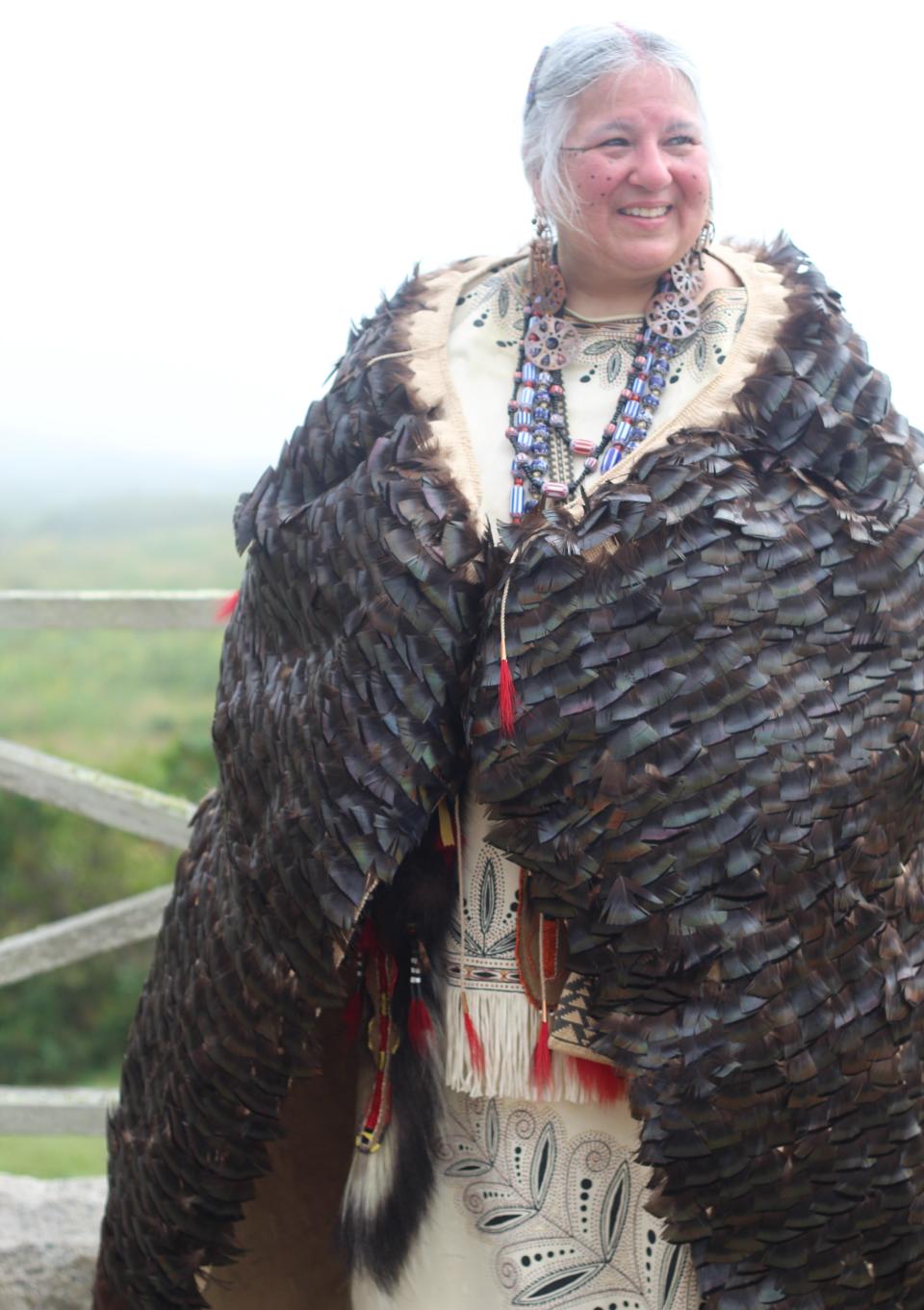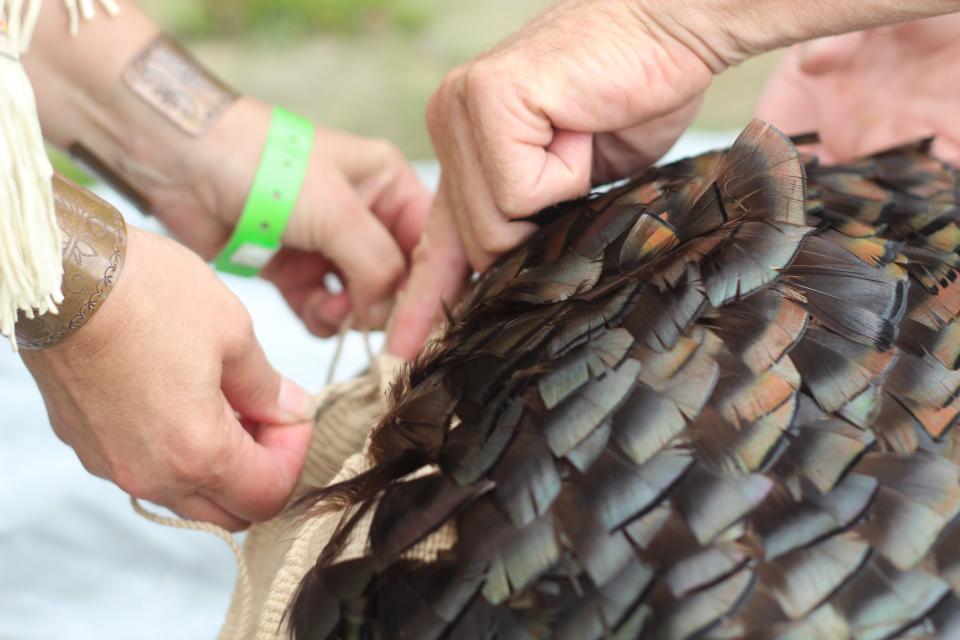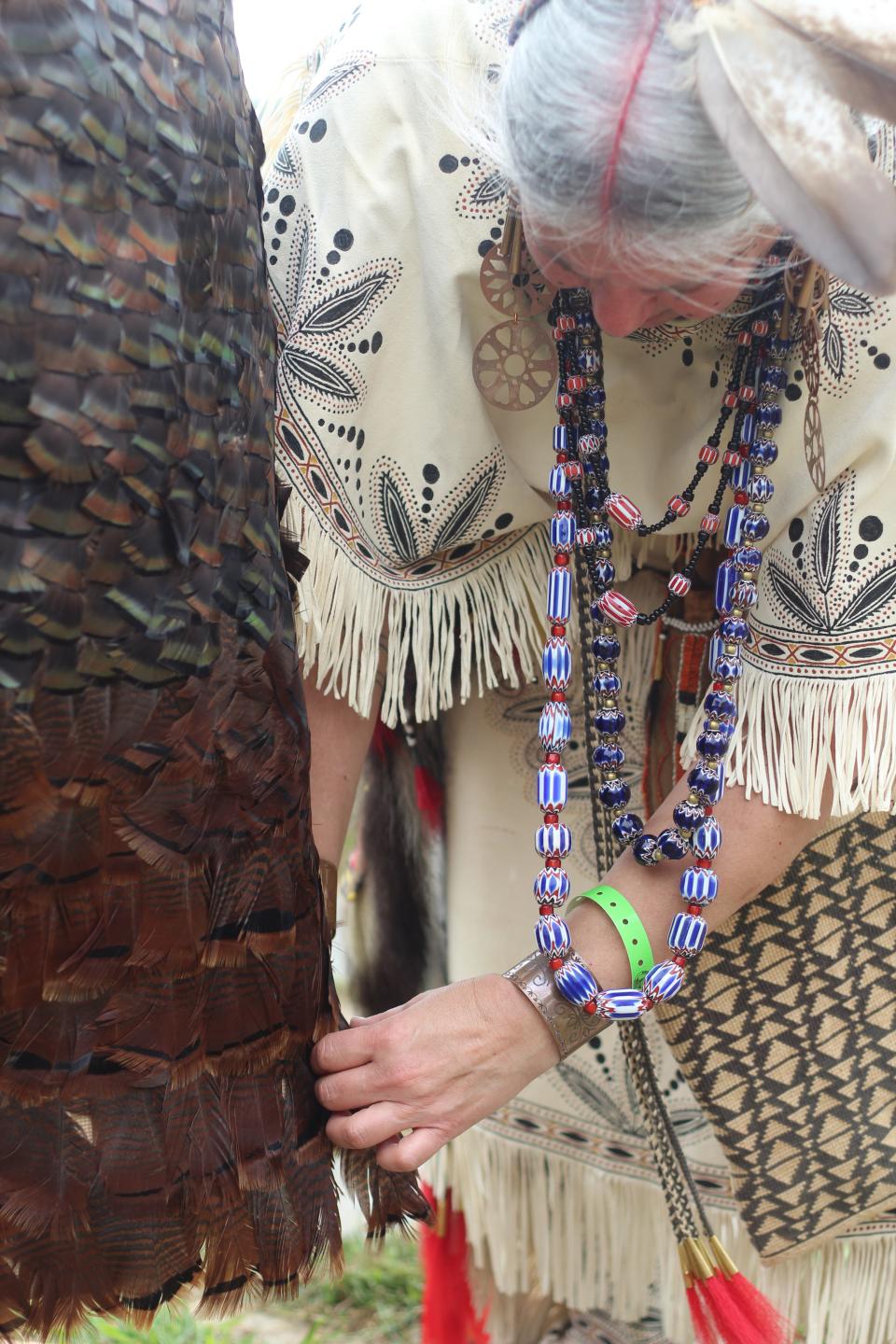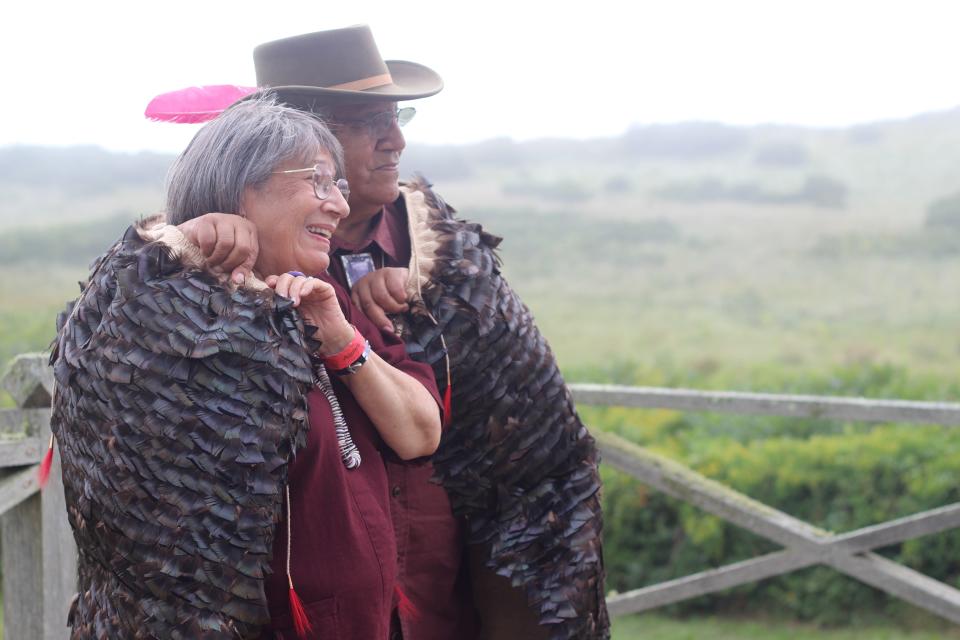First in 400 years. Turkey feather mantle unveiled at Aquinnah Wampanoag Tribe Powwow
AQUINNAH — A drum could be heard in the distance as an intimate group of tribal elders gathered Sunday at the Vanderhoop Homestead and Aquinnah Cultural Center — structures that overlook striated, multicolored clay cliffs and the Atlantic Ocean.
Julia Marden's hands shook as she unwrapped a 4-foot by 6-foot turkey feather mantle that took her, a member of the Wampanoag Tribe of Gay Head (Aquinnah), about a year to twine by hand. As elders took turns wrapping themselves in the cape-like garment, tears streamed down Marden's face.
"It means so much to debut the mantle here in Aquinnah," said Marden, who is known internationally for her traditional weaving and painting techniques. "This is why I made it. I couldn't ask for anything better than this. This makes all the work worth it."
While there are other feathered mantle's in existence, the ancient twining technique Marden used when creating the piece is what makes it special, she said.
"The turkey feathers are close-twined and embedded into the cape," she said. "No Wampanoag has twined a mantle in 400 years."
While the mantle has been completed for roughly a month, Marden said she waited to reveal the piece at the Aquinnah Wampanoag Powwow so family, friends, and tribal elders could be the first to wear the garment.

Cynthia (Vanderhoop) Akins, an Aquinnah Wampanoag tribal member and elder was surprised by the weight of the mantle.
"It's heavy!" Akins said. "You feel important when you have this on."
Cheryl Andrews-Maltais, chairwoman of the Wampanoag Tribe of Gay Head (Aquinnah), also donned the mantle. The finished garment, she said, makes the tribe proud.
"It feels very empowering. You can feel the energy of the ancestors in it," said Andrews-Maltais. "And the hues of the feathers in the sunlight — it's phenomenal."
Marden, who is from Falmouth and now lives in Vermont, was also scheduled to speak to tribal members and the public about the mantle during an artist talk Monday at the Vanderhoop Homestead, said NaDaizja Bolling, director of the cultural center.
"So much valuable information has been captured throughout Julia's journey with this cape and as Wampanoag people we cherish this kind of history that will live on," said Bolling. "Julia is an inspiration to us all."
For Marden, the mantle is one of the most powerful pieces she's executed in her lifetime.
"It’s been haunting me for 30 years and it's been a race against time to complete it," she said. "There's been a lot of pressure because none of our (original twined) mantles survived. This had to be done for our people and Wampanoag community."
A turkey feathered mantle has been a long time coming

Six years ago Marden began the twining process for the mantle. But health complications forced Marden to put the large-scale project away for about five years. When she picked the project back up in 2022, she slowly began to weave two rows a day.
"I realized I’m getting old and I’m running out of time," she said. "By the time I got brave, it was almost past the time to do it."
It took Marden a few months to sort turkey feathers, which were sourced from California, and about a year to weave the body of the mantle and the neckline. But the idea for the mantle occurred to Marden when she began working at Plimoth Plantation's Wampanoag Indian Program in 1991. While the museum, which is now known as Plimoth Patuxet Museums, fell out of favor recently with Wampanoag communities, she said, at that time, staff was taught traditional crafts by Wampanoag people.
"All the staff learned traditional arts. I learned how to twine from fellow employees when I first started," she said. "And I've been weaving ever since."
When she learned that mantles existed in Wampanoag communities before colonization, she said she knew she had to make one. "This would have been worn by people of status on big occasions — any ceremonies or when you want to show up in a big way," said Marden. "It's definitely not your everyday wear."
Twining was essential for Native communities around the world
Much of the difficulty in creating a mantle is the ancient twining technique, said Marden.
"Twining is the oldest form of basketry there is worldwide," she said

Traditionally, the turkey feather mantle would have been made from spun cordage from natural plant fibers like dog bane, milkweed or false nettle. The plant fibers would be gathered by Wampanoag families after plant flowers began to dry naturally, said Marden.
“We didn’t use a drop spindle or a wheel of any sort,” said Marden. “We spun all our cordage by hand and a good spinner could do it in one back and forth motion.”
Wampanoag spinners would begin learning the cordage process from early childhood and spend their lives working on fancy projects like mantles. But they also made bags that tribal families used for practical day-to-day living. From food and seed storage to bulrush mats that were used to insulate winter homes like wetus, spinners were incredibly important, said Marden.
“It was essential for every household to have woven items. We didn’t have cabinets and closets in the wetu,” she said. “Everything we owned were kept in baskets and bags.”
Because of colonization, genocide, slavery and war, the art of spinning was nearly lost in Eastern Woodland territory, said Marden, who used cotton cordage to craft the mantle.

Over time, the art of twining also fell out of favor when new materials were introduced.
“Spinning is a time-consuming craft so not a lot of people still do it,” she said. “New technology has also intervened. Now you can go to the grocery store and buy machine-made bags and buy any kind of cordage that you want."
Twining and weaving is also an emotional process for Marden
While the mantel is Marden's most recent project, she has also made a name for herself by bringing back the ancient techniques of false embroidery, particularly porcupine false embroidery, and traditional overlay.
"It's become my purpose to bring these techniques back to community," she said.
Marden is also a master weaver and has built entire collections of traditionally-made baskets and bags. Her work has been displayed in Native American museums across New England, including the Mashantucket Pequot Museum and Research Center; and the Robbins Museum of Archaeology in Middleboro.
"The process behind these projects is very emotional and it’s very powerful," said Marden. "Much of the work takes a long time and I spend a lot of personal time with each piece."
Next year, the mantle will also make its way back to the Aquinnah Cultural Center, said Bolling. For the last year, Bolling and her sister Tysonnae Aiguier-Bolling visited Marden at her home in Vermont to document the mantle-making process. After the garment tours a series of Wampanoag communities, the mantle will be on exhibit at the cultural center, with an accompanied short film produced by Bolling and Aiguier-Bolling.
"Most people don't think about the effort, energy and time that went into this piece. She's so giving in that way and we can all learn so much from Julia," she said. "This is the type of knowledge that's meant to be shared within community."
Marden has plans to create a rabbit skinned twined blanket, though she said the mantle was "an extremely humbling amount of work."
"Getting to the end, I could feel my hands going," she said. "This is my coup de grâce. It will most likely the most important piece I ever do."
Rachael Devaney writes about community and culture. Reach her at rdevaney@capecodonline.com. Follow her on Twitter: @RachaelDevaney.
Thanks to our subscribers, who help make this coverage possible. If you are not a subscriber, please consider supporting quality local journalism with a Cape Cod Times subscription. Here are our subscription plans.
This article originally appeared on Cape Cod Times: Nearly a lost art. Aquinnah Wampanoag unveils twined feather mantle

